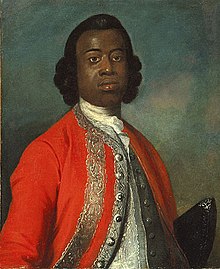William Ansah Sessarakoo
William Ansah (or Unsah) Sessarakoo (* probably 1736–1749) was the son of a wealthy African trader who was abducted into slavery in the West Indies . After his liberation, he came to London , where he became famous.
Sessarakoo was the son of a wealthy brafo (chief) from the Fante people , who traded near Fort Fort William in the Netherlands near the city of Anomabo on the West African Gold Coast in what is now Ghana . His father was known as "John Corrente" and traded in gold and slaves. John Corrente decided to send his son and a companion to Europe so that he could learn European business practices there and thus increase his business success. The European captain to whom he entrusted his son, however, abducted Sessarakoo to Bridgetown in Barbadosand sold him there as a slave. The captain died soon after, but Sessarakoo's father discovered the treason and refused to trade with the English until his son was released. The Royal African Company then arranged the ransom of Sessarakoo through local dealers.
Sessarakoo was brought to London, where he was under the protection of George Montagu-Dunk and treated as a "foreign prince", as the "Princ of Annamabo" and introduced to George II . He became a celebrity and was compared to Oroonoko , a fictional African prince from a novella by Aphra Behn , who had also been sold into slavery. He attended a performance by Thomas Southerne based on Behn's novella. His portrait was painted by Gabriel Mathias in 1749. The representation of the portrait was extremely unusual for the time, as an African was portrayed as an individual. His story inspired William Dodd to write his poem The African Prince. In 1750 his memoirs were published under the title The Royal African: or, Memoirs of the Young Prince of Annamaboe . He later returned to Africa.
Web links
- Portraits in the National Portrait Gallery , London (English)
- Between Worlds , National Portrait Gallery , London (English)
- The Royal African: or, Memoirs of the Young Prince of Annamaboe at Documenting the American South , docsouth.unc.edu (English)
literature
- Wylie Sypher, The African Prince in London , Jour. Hist. Ideas, 2, 2 (1941) 237-47.
- Hakim Adi : West Africans in Britain: 1900-1960: Nationalism, Pan-Africanism and Communism . Lawrence & Wishart, London 1998.
Individual evidence
| personal data | |
|---|---|
| SURNAME | Sessarakoo, William Ansah |
| ALTERNATIVE NAMES | Sessarakoo, William Unsah |
| BRIEF DESCRIPTION | Son of a wealthy African trader who was abducted into slavery in the West Indies |
| DATE OF BIRTH | between 1736 and 1749 |
| DATE OF DEATH | 18th century |
